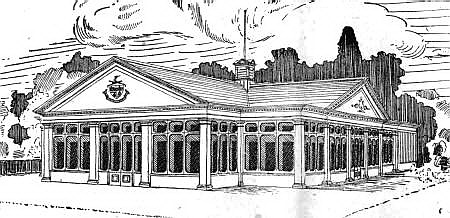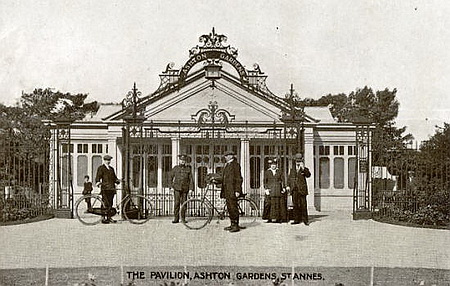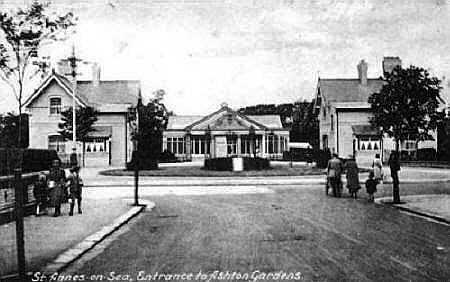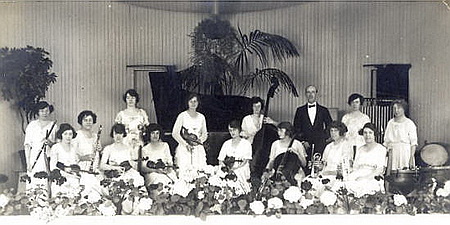|

Architects sketch of the new pavilion, 1916.

The Ashton Pavilion shortly after completion in 1916; this was
wartime so soldiers in uniform were commonplace.

The Ashton Pavilion viewed from Garden Street c1918

Miss Whittaker's Orchestra, Ashton Pavilion, 1921. Herbert Whittaker was
conductor when the pavilion opened in 1916.
|
THE ASHTON PAVILION
CONCERT HALL FOR SUMMER OR WINTER
The above drawing represents the Ashton Pavilion, opposite the St. George's Road
entrance to the Ashton Gardens. It was designed by Mr. J. S. Sawdon, A.M.I.C.E., Surveyor to St.
Annes Council, and is being erected under his supervision. When completed it will be a handsome and
tasteful structure, and well-built, which is a characteristic of Mr.Sawdon’s work.
The original idea was to erect a band pavilion, on poles, with open sides,
filled in with lattice work. This would have been available for use in the summer only, and as the
scheme was being developed the Council considered it advisable to convert it into a hall, which
could be used all the year round.
The pavilion is built on poles which will be encased in Doric columns and
surmounted with Ionic cornice and impressive pediments and entablature in three elevations. The
spaces between the columns will be filled with folding partitions, which, when folded, will fit
close to the columns, and which can be closed in inclement weather. The partitions are fitted with
plate-glass with a small panel of green Arctic glass at the top. By this arrangement there will be
light without the heat of the sun in summer.
The roof is formed of timber principals and the ceiling of lath and plaster. The
roof is covered with red asbestos tiles. A wall about 2ft. high has been erected round the building
to form a draught-screen in the winter, but in summer it will not be any obstruction to any of the
audience sitting on deck chairs on the lawn. It is proposed to face the walls inside and out with
cement.
The pavilion is 50ft. by 60ft., with seating accommodation for between 500 and
600. The floor will be of maple so that the hall can be used for dances and other social functions
in the winter. No doubt the Council will provide comfortable seating accommodation and carpet. The
stage will be 30ft wide and 16ft. deep and flanked by ladies' and gentlemen's dressing-rooms.
Provision has also been made for a tea-room, from which afternoon teas can be served.
The hall will be lighted by electricity, and heating apparatus will be installed
with radiators where necessary. Ample provision has been wide for ventilation.
The pavilion will be decorated in cream and white; the columns entablature and
pediments in cream, and the folding screen in white. The hall is built in line with the ornate
gates, the design of which will he brought into strong relief against the light background. With
red tiles and a light structure against the green foliage of the trees, the building should be very
pleasing to the eye as well as most suitable for the purpose for which it is intended.
|